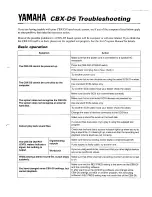
34
SETTINGS AND OPERATION
— Continued
of delivering a sufficient amount of undistorted power. Strange as it may seem, too
low of a power rating on your A/V Receiver or amplifier is more likely to damage
speakers than one with a higher power rating. That’s because when an amplifier is
called on to deliver more power than it was designed for, it will produce distortion
called clipping. This distortion is very harmful for speakers.
Using Your A/V Receiver’s Setup
Now that you have your system placed and connected it is to setup up your
system with the setup menu in your A/V receiver. Please refer to your owner’s man-
ual. One setting you may need to set is speaker impedance. If given the choice, set
all speakers to 6-8 ohms. This is correct for your RSL Speakers.
All of your RSL’s are eager to pour out their little hearts for your viewing and
listening enjoyment. All they ask in return is for you to provide them with the opportu-
nity by properly balancing them. There are several methods of balancing your speak-
ers. Almost all A/V receivers have the ability to play a test tone through each individ-
ual speaker. Usually this noise is either white or pink noise, which sounds like a
bunch of hiss. This sound is very handy if you wish to balance the sound manually.
Using your A/V Receiver’s Auto Setup
Most current A/V receivers have some sort of automatic setup. They supply a
microphone that you place at your main listening positions. Then, they play test tones
through each speaker individually (while advising you to maintain silence during this
process). Based upon these measurements, the receiver will automatically calculate
speaker distance, individual speaker and subwoofer volume, and crossover points. In
addition, most receivers employ room correction equalization. The most popular form
is Audyssey
TM
. In many cases this room correction can improve the sound where the
acoustics of the room are less than ideal. However, we have found some cases
where the sound is better if the room correction equalizer is turned off. You should
experiment with it on and off to determine which setting sounds best to you.
Please refer to your A/V receiver’s manual and how to use its auto setup fea-
ture. As handy as this is, we need to caution you about a few things. First, it will often
set the crossover to the wrong frequency. After you do run auto setup, we recom-
mend going into your setup menu and setting every crossover including the sub-
woofer’s to either 90 or 100 Hz.
When balancing your speakers, keep the following in mind:
1. The goal is to create a 3 dimensional sound environment all around you. For
this you may need to increase the volume of your surround speakers anywhere
between 2 and 4 db.
2. We recommend setting the center channel speaker volume an extra db or 2
higher than the auto-setup. This will help the clarity of dialog.
3. Set the subwoofer strictly by ear. Set the volume control on the subwoofer’s
remote box so that it points to the 12 o’clock position. Play some music with a
constant bass track. Then set the subwoofer level in your receiver according to
Summary of Contents for CG24 Monitor
Page 2: ......













































